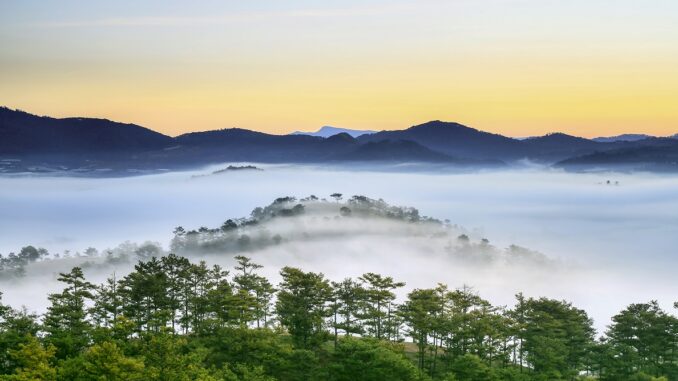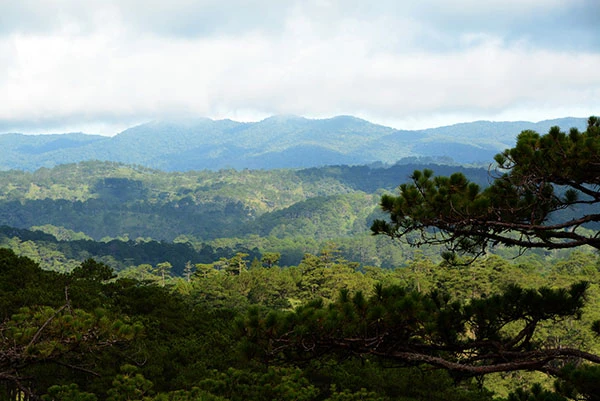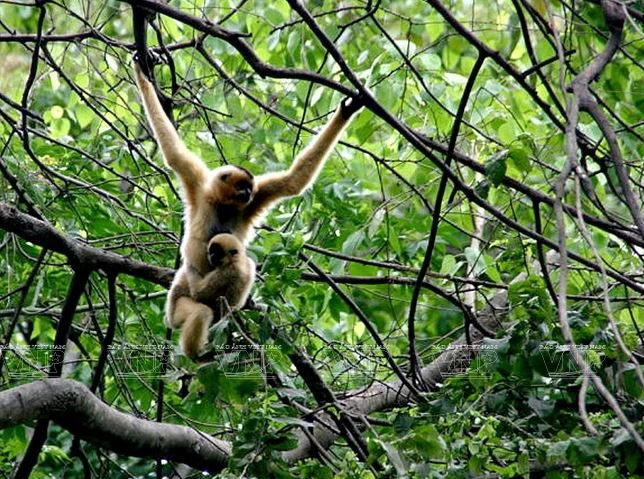
Located north of Lam Dong province, it covers 275,439 hectares of land and boasts a large primeval forest whose core is Bidoup – Nui Ba National Park. It is assessed as one of the four biodiversity centers in Vietnam.
Located at altitudes ranging from 650 meters to 2,300 meters, Langbiang is home to a great diversity of natural ecosystems, including terrestrial and aquatic ones. It also harbors all the natural forest biotopes, which are the habitat for wild animals.
The diversity of natural biotopes, from woody and bamboo mixed forests and scrubland to grassland, has contributed to the richness of reptile, amphibian, insect, and flora species. Meanwhile, aquatic biotopes such as lakes, rivers, and streams in the middle of the forest not only form beautiful landscapes but also create ecosystem transitions and act as the habitat of fish and other aquatic species.
Ecological features
– Forests: Lang Biang Biosphere Reserve is covered by forest ecosystems, including low mountain evergreen forests, coniferous broadleaf forests, primary forests, alpine dwarf forests, moss forests, bamboo, and savannas. Low mountain evergreen forests occupy the largest area, with popular tree species such as three-leaf pine, pitch pine, otter oil, etc. Broadleaf coniferous forests are distributed at medium altitudes, with common tree species such as green ironwood and stone pine.

Primary forests are distributed at high altitudes, with ancient tree species of high economic and scientific value. Alpine dwarf forests are distributed at altitudes above 2,000 meters, with low tree and shrub species. Moss forests are distributed in humid areas with rich moss species. Bamboo and steppe are distributed in grassland areas with diverse bamboo and grass species.

– Animals: Lang Biang Biosphere Reserve is home to many animal species, including rare animals such as saola, black bear, white-cheeked gibbon,… Other popular animals include monkeys, deer, gibbons,…
– Aquatic flora and fauna: Lang Biang Biosphere Reserve is also home to many aquatic flora and fauna species, including fish, shrimp, crabs, snails,… These aquatic flora and fauna species are important in balancing the region’s ecosystem.
– Terrain characteristics: Lang Biang Biosphere Reserve is located at an altitude of 650 to 2,300 meters above sea level, with diverse terrain, including mountains, hills, grasslands,…
– Climate characteristics: Lang Biang Biosphere Reserve has a tropical monsoon climate, with average temperatures ranging from 18 to 25 degrees Celsius and average rainfall ranging from 1,500 to 2,500 mm/year.
– Land characteristics: Lang Biang Biosphere Reserve has diverse land, including fertility soil, humus soil, alum soil,…
– Hydrological characteristics: Lang Biang Biosphere Reserve has a rich system of rivers, streams, lakes, and ponds, providing water sources for living, production, and ecology.
Efforts made for conservation, sustainable development
Government efforts
Governments at all levels need to have specific policies and regulations to protect and develop the Lang Biang Biosphere Reserve. These policies should focus on the following issues
– Forest protection: The government needs to strengthen control over illegal logging and deforestation activities. At the same time, there needs to be measures to support local people in converting to sustainable, environmentally friendly production models.
– Protecting wildlife: The government needs to take measures to prevent illegal hunting and trading of wild animals. At the same time, there needs to be research and conservation programs for rare wild animals.
– Education and awareness raising: The government needs to promote propaganda and education to raise awareness of local people about the importance of protecting the Lang Biang Biosphere Reserve.
Efforts of the local community
Local communities need to raise awareness of nature and environmental protection. Households need to take measures to minimize environmental pollution and protect water sources, forest resources, etc. At the same time, they need to actively participate in nature and environmental conservation activities.

Efforts of organizations and individuals
Domestic and foreign organizations and individuals need to join hands to protect the Lang Biang Biosphere Reserve. Organizations can assist local governments in developing and implementing conservation plans. Individuals can participate in activities to protect nature and the environment, such as planting trees, and participating in ecotourism programs,…
With the efforts of all levels, sectors, and local communities, the Lang Biang Biosphere Reserve will be protected and developed sustainably, contributing to the environmental protection and socio-economic development of the country.
Conclusion
Lang Biang Biosphere Reserve is Vietnam’s 9th world biosphere reserve recognized at the 27th Meeting on June 9, 2015, of the International Coordinating Council of the Man and Biosphere Program under UNESCO. The Lang Biang Biosphere Reserve is a treasure trove of biodiversity and a natural heritage site of immense significance. Its diverse ecosystems, unique species, and ecological services make it a vital asset for both conservation and sustainable development.
Preserving the Lang Biang Biosphere Reserve requires a concerted effort from all stakeholders, including the government, local communities, and businesses. The government must play a leading role in developing and implementing policies that protect the reserve’s natural resources and promote sustainable development. Local communities must be engaged in conservation efforts and empowered to benefit from the reserve’s resources. Businesses must operate responsibly and support sustainable practices.
Get an opportunity to visit the Global Biosphere Reserve in Vietnam through Vietnam E-Visa!